BLOOD AND SPERM
I ALWAYS WANTED TO BE AN INDIAN BUT I BECAME A PAINTER INSTEAD.

An interview with Belgian artist Alann De Vuyst which took place in November 1997 and Mr. Philip Keen art amateur alias DH as the interviewer.
Mr. Keen met Alann De Vuyst in the fabled city of Udaipur, known as the Venice of the East. One of the many jewels the British Raj had conquered to add to the British Empire for several centuries. Nowadays, one finds backpackers and tourists mingling with the colourful residents. A place for many a painter, foreign and local, to feast upon.
It was sheer coincidence or may we call it karma, when DH and Alann met in a small restaurant. Overlooking the Rang Sagar lake with a Kingfisher beer by the hand seemed the right moment to discuss art. On the second occasion they decide to talk about Alann’s art and nomadic way of life.
Below you find the resume of an interesting albeit lengthy conversation.
The interview is illustrated with his works made between 1988 and 2003.
DH- Alann, we need to get facts down. There's different ways we can approach this, perhaps the best way is through the paintings, to see if you can pull things out from your past, which then would help to get a picture together. I see that you use blood in conjunction with sperm as a part of your pictures. Can you tell me little bit about this?
A- Well, the blood and the sperm is something that has very much to do with physicality. It is part of our DNA and blood is something I also experienced with the tribes I stayed with. For example: a blood pact with the Shavante nation in Brazil.
H- Yeah, we ought to bring in the pictures a bit more, hah?
A- A- I've said this before on a website: Why did I depict hanging people? And I am sure now that as a kid, I've actually buried it in my subconscious, because I now realize it is a very vivid memory of something I known when I was thirteen. Twice I have seen a noose put up there in the attic, by a close relative, who had tried to hang himself. Then again, in 1995 I‟d heard stories of two black young boys who had been hanged by some rednecks in Brazil.
DH- Yeah A- A hanged person releases sperm: ejaculation. Death and life is close together. Or somewhere like... in that pop song… Queen sang it: “Pain is close to pleasure.”
Before
DH- Yeah. A- A hanged person releases sperm: ejaculation. Death and life are inextricably linked together. Or somewhere like... in that pop song… Queen sang it: “Pain is close to
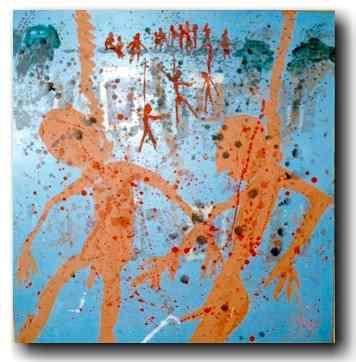 the Revolution (1997, Rajasthan/India)
the Revolution (1997, Rajasthan/India)
pleasure.”
DH- Yeah, which is - I do like a bit of philosophy: and it's something like two opposites are a union to make a whole. It's hard to take that literally when you're talking about good or bad, because, you know, there...Such happiness and such things as sadness, I don't like to see life in a fiftyfifty split to make a midway point. It's difficult, very difficult. Yeah, blood is often termed such, in terms as morality. Is there any connection there at all?
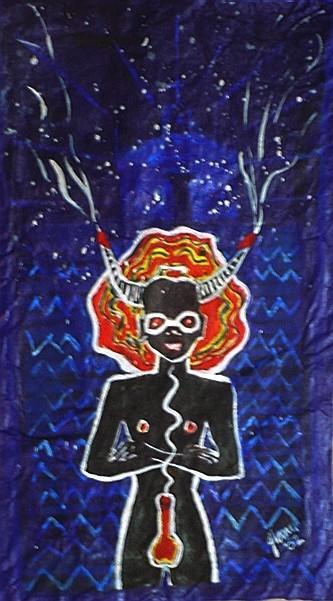
I hope you guess my name (2002 Goa, India)
A- Yeah, I still feel that all the things that come from our body, in the West, are seen as something filthy. Don‟t you think so?
DH- Yes.
A- How many people enjoy the feel of sperm on their body? You don't even want to rub into your body, though it's a nice sensation.. It's sticky; it has a nice feel to it. It is part of loving your own body, and the fluids are part of it. The same goes for blood, when you bleed you put a plaster over the cut in your finger. But I prefer to lick or suck it up. I just want to keep it in me.
When people have to face my works... I mean, when they are confronted with depictions of blood and sperm in my paintings. I can see the shock in their eyes. Why are people shocked at that?
DH- Well, I personally fear having to experience the worst of that. For me one of the nice things about paintings... You can have vicarious sympathy. Vicarious is where you enjoy. Strangely enough, there's an odd sensation I had after, because I did enjoy the fact I could look at a picture of yours and place myself there and return unscathed, but having learned a little something. As to why blood is an initial shock? You know, this says to me this is happening. A- I didn't paint that you see. When I was making those paintings…and this is why it is a sort of thermometer for me to find out whether my painting is good or not - Let me put this way...If I don‟t get excited, if I don‟t get aroused, then I think my painting is worthless and by arousing I mean: my blood gets stirred, eh, I feel feverish when I am making a painting.
DH- Now, we're going to hit something important here. What is tribalism? You could as a painter paint people with open guts pieces of white bone, flesh, and blood in a
straight representation of what is...however you represent in tribal rights. You seem to be able to say more for some reasons; it seems to be able to give something extra, which a straight bloody representation doesn't give.
A- Well, maybe what I want to show, in fact it comes much more...see we always talk about the savages, right? Tribal people are called savages; and believe me or not, I just read it again today.
DH- Ya. A- Savages… just today I read an article in the Indian Times, I quote: “everything should be done to stop them drinking all the time, we should civilise the backward tribes. They should put them in ashrams where they could be controlled and get some education.”
Whereas I believe that every invasion or attempt to interfere in tribal communities by the authorities is one of savages. You see, in a conservative newspaper (The Daily Telegraph/ Calcutta 1997) they called them “backward tribes”. Every intellectual, when confronted with these words during my "Tribal Connection" show, aggressively denied that Indians would hold such a vision.
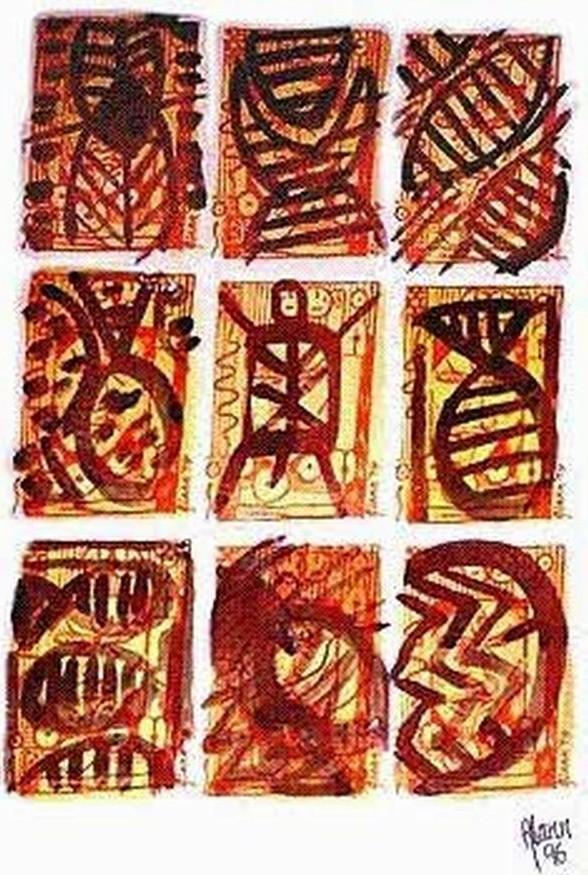 Back to Maha Kali’s Roots. (1996 Kolkatta/India)
Back to Maha Kali’s Roots. (1996 Kolkatta/India)
DH- Yeah
A- And should first look at themselves how they treat their own people. I don't believe that if you keep your people starving in the streets, the same way Brazil does or the whole of South America does. How can you look into the mirror and say that you are a civilised person and that you are going to bring civilisation to the savages? I think it's even more shocking if I„d paint in a tribal style about savagery, which is done by the people who claim to be civilized people.
I made some ready-mades last year. I bought a plaster copy of Jesus Christ as a little boy, with his father and mother Mary and Joseph, and I gave Mary a knife in her hand, which was actually a claw, a nail from a turtle, which I had found on the beach of Puri in Orissa State.
Why a turtle‟s nail, you might ask?
I found it was just what I needed for that piece, because the Native Americans believed they were living on the carapace of a turtle. That's why it in their native tongue it was called „Turtle Island‟...So, I used symbols and combined them with these ready-mades (see Dadaism), which I painted in a tribal style.
I once talked to a young Shavante who said: “How can we believe in your world or your God when you can even crucify your own God? How can he be a God if you can do that?”
Hence, I painted the Holy Family in yellow and they were bleeding from their heart.
 The Holy Family. (1996 Kolkatta/ India)
The Holy Family. (1996 Kolkatta/ India)
I made Joseph bleed out of his heart and mouth. Mary bled from her bosom from her mouth too, because though they knew of their son Jesus‟ fate; they pretended to give him an innocent childhood, in a way as if they had agreed with his future crucifixion.
So they were telling lies to Jesus, while Jesus too knew what his fate was. I made them bleed from their genitals, because of the Immaculate Conception, because they had never used their genitals to make Him in the first place, and for the sacrificing of their Holy Son who turned into an ordinary man (After all he had become Man).
I made the Little Boy bleed out of his heart as well, because he loved his parents. However, he also knew that he was going to die, and that he was going to carry out his mission. That was a very striking and shocking image, but I found it interesting that people, who visited my show, including some Catholics who worked for Mother Teresa, preferred just that piece. The same goes for my last exhibition in Calcutta where I had the penis, crucified on the cross. It was called „Our Lord‟.
An Australian correspondent, who was working for Mother Teresa then, was reported to have said: “I believe that every Catholic family should have that picture in their home 'cause it's the very essence of Christianity. A Jewish girl from New York said: “It‟s the essence of our religion.”
DH- Yeah, we ought to bring in the pictures a bit more, hah?
A- Well, in that sense what I am painting is the restoration of things that have been censored or destroyed by overzealous bigots, fundamentalist Christians, the Taliban and Ayatollahs. What I mean is, I want to paint things, which were hitherto hidden for me, which were hidden for other believers from other nations.
 God Min
God Min
Whenever you visit the temples of ancient civilisations, like I did last year in Egypt, one wonders about many things. I went through the Egyptian Museum in Cairo and I asked myself: Where are their paintings and depictions of their sexual life in that era. And there were none, except for that ithyphallic God Min with a hard-on. There was no other sexual image around. So I thought that it had either been covered up by Muslim fundamentalists or maybe by early Orthodox Christian. Or they never had it, which I couldn't believe.
Back in Belgium, I saw a documentary of an anthropologist who explained that the West had such an idealistic view, an illusion about the Egyptian civilisation, one of the highest on earth, that when they discovered those anthropomorphic deities with an erection, they were so shocked that they smashed it all to pieces. They couldn't accept those things.
Still nowadays, in the British Museum in London God Min is still on display, but with a plaque tagging „God Min‟, which coincidentally and conveniently covers his genitals. Hence, his erect phallus is nicely hid for the public. I mean, even these days they are still censoring history. They still can't face sexuality in particular of a civilisation put on a pedestal.
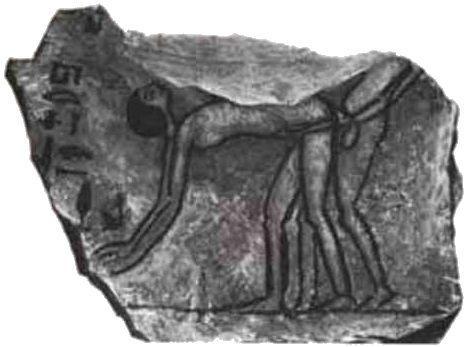 Ancient Egypt...censored heritage...
Ancient Egypt...censored heritage...

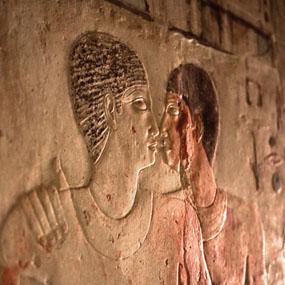
CHAPTER II: SORCERY
A- Sorcery is still very active and omnipresent in many tribes.
DH- I found this very interesting that you were accused of sorcery (at the Shavante village in 1989) because that's to me, that is a propos. If we look in terms of what sorcery is then an anthropologist...There's no reason why you shouldn't be one as a painter.
A- Painting on a canvas, so to speak, did not exist before in cultures of oral tradition, and thus a painter creates, conjures like a sorcerer can create. It is a thin line to walk and can provoke controversy, which is what I do with my paintings. One can understand how it can be seen as creating something evil, or putting a spell on someone. When tribal people paint utensils of daily use, I don‟t think they think of art. More likely they think they give the object power.
DH- Mmmh
A- But it came a bit as a shock to me. I mean, there I was, confronted with American and Brazilian Evangelists. The Americans, how lived in the adjacent village, had enjoyed their piece of the cake for the last thirty years in that area. I was interfering with their business; I told him I was an atheist, a heathen, and I frankly admitted not to be religious at all. That‟s when the chief (my blood brother) asked me: “So, Wéré‟è (my adoptive Shavante name), what do you think about the Bible?”
 Jerônimo Xavante (1995 a mural in Barra do Garças/ Mato Grosso/ Brazil)
Jerônimo Xavante (1995 a mural in Barra do Garças/ Mato Grosso/ Brazil)
DH- Yeah
A- “What do you think of the Old Testament or the New Testament?” At the same time a Brazilian evangelist was walking next to the chief on the other side. I answered: “Well, I think these are just myths and tales, I think that your religion is as valuable as ours and you should restore it or ignore it. And then he would say: “Well, how do you feel about Weré‟é‟s answer? To which the preacher said: “Our Lord said: “I am the truth and if you don't follow me you will not get to my father.”
DH- By me, He could have meant: “I am the truth” and otherwise “The truth is me” or “The truth is truth” yeah? ”And only through truth can you reach God” this is what it most probably intended.
A- Yeah.
DH- I mean, he is a modest man. He wouldn't just say: “Only through Jesus”, would he? He means: “I am the truth; I am synonymous with the truth”.
A- Yeah.
DH- Now, the truth is: “I am the most truthful person” and you will find truth through truth, really or we can't say is truth through Jesus but if He was a modest man, which I believe he was though that's that what it really meant.
A- But, on the other side he's...
DH- Truth is something you behold. You behold it.
A- In a sense. On the one hand, he was this peaceful man, but on the other hand he says: “I will also bring you the sword”
DH- Ah, yes, I hear this.
A- So, the Jesuits Order was founded on this principal. They wanted to be the soldiers of Jesus Christ with the sword in the hand wanting to create a Utopian society.
DH- Right, so you had...right, ahm, Krishna, also similarly, you know, most of what is depicted in Krishna is. He enjoyed and obviously joined the bathing pool and the girls, you know and he had this fabulous relationship in the village, There again we have the other side where there was a practical war and he was a warrior.
A- I painted Krishna a couple of times.
DH- Yah A-There is one called “Heaven is Hell”, where you can see a Krishna picture and at the bottom you can see two animals copulating or practicing sodomy. I have them doing the same thing in “Hell is heaven”.
 Hell is Heaven (1997 Rajasthan, India)
Hell is Heaven (1997 Rajasthan, India)
DH- Mmmh.
A-Because sodomy was a mortal sin and despised by Christians. In Spanish history books it is written that the Spanish conquistadors believed they had all rights to exterminate the Indians, because the Indians were practicing sodomy, which was “an abomination in Jahweh‟s eyes”. But of course it was another excuse to take their land. The other excuse they used for that was that they were cannibals.
I went onto say: “I have a Krixna (Brazilian spelling) painting called „Divine‟, where Krixna has sort of a...he's naked.
DH- Yea.
A- Sort of dancing, he could be wearing his penis up, like the (Brazilian/Venezuelan) Yanomami tribe does, with a string around the foreskin tied to the belly. It could also be an erection. Krishna was surrounded by a lot of gopis (female cowherds).
I cannot see why Krishna could not have been aroused by these women and not get a hard-on. But, to say this in India would be asking for trouble and create a controversy.
Who knows the Indian people would want to stone me to death. In point of fact I had a conversation with an Indian official visiting during my exhibition in Udaipur. He then asked me: “Is this Krishna? (Loud) Is this Krishna” To which I said: “My painting is called „Divine‟ and you have to find out for yourself what is „Divine‟ on the picture.”
 Xavante Krixna (1996 Kolkatta/ India)
Xavante Krixna (1996 Kolkatta/ India)
Had I said 'Krishna', it would probably have turned out in a riot in the streets of Udaipur, accusing a foreigner of having painted Krishna naked with an erection. However, Krishna is one of the only avatars one is allowed to represent in an erotic way; one can get away with it depicting him naked. He was a frivolous figure who played lots of pranks, but a god with an erection? They do exist, though. Shiva with his consort Parvatí...I have seen sculptures and miniatures, but just as in the west the pressure is on to hide that past.
Like Mr. M.F. Hussein (contemporary painter, known as the Picasso of India) had his trouble recently with his an old etching of goddess Saraswati in the nude.
I could have had a major story if I had wanted to make a fuss out of it and become famous overnight. But I just said: “No, the title is „Divine‟.”
I could have called it „Krixna‟. Like all my other works I called „Krixna‟, hence the avatar has become an Amazonian Krishna (through a change from English to Brazilian spelling). If Krishna had gone into reincarnation with the Shavante (in Brazil spelled Xavante) Indians he would have been called 'Krixna' instead of 'Krishna'. He would have had a different identity had the Shavante tribe adopted him.
DH- Ya.
A- Yes, for the same reasons, Jesus Christ had different identities. Wherever he was introduced by the missionaries; whether they were South-American, Asian or African societies, he had both his Christian and indigenous powers merged into one identity. In Europe he was a blond blue eyed and fair skinned baby, in South America he looked like an Indian, certainly never like the Jew he was.
DH- Mmmh, so, the justification is the benefit; there's something very precious about culture.
With regards to your picture we were talking about perspective the other day and you can't have everything in a picture. So, one chooses to compromise, some things are more important. You appear to put layer upon layer.
A- Mmmh
DH- But this is not initially. Initially you can't make this out, until you start to get to know the picture. Then you can see the strata, maybe five or six quite tightly framed colours. This is a strata whereby you've gone, painted here, and then you've drip-painted another far better effect, and then you've painted again and in the end usually in the last part then you use the very strong red colour, which I suspect maybe you've put a dash of black in there.
A- Yeah, I don't use the black; I never use the full black. I blend it with blue 'cause I think, how should I put that, err...I don't believe in techniques you see as I tell people. I am a self-taught painter, o.k. I had skills taught at school where I was trained as a creative director, but I've never ventured into becoming painter. I was only sixteen. I never thought I would be a painter... I wanted to express myself through drawing. DH- Yeah
A- So, I think that technique in my opinion... Technique is not all for me. What is all is what you want to say and the means to say it are different. Look, when I observe the patterns of tribal people I never saw perfection. Their pottery had geometrical forms painted either with a stick or with a splinter of a palm leaf and it was dripping. They wouldn't wait also too long to make the paint dry. They would straight put it into the fire. It was the moment of doing. And it's the same for me. The moment I'm painting I'm happy, and it's not like I am working to the result, it is the journey of painting, the moment itself that I enjoy, and I don't care much for perspective or relief or al those other
things that come into realistic painting. I am not into that at all. I want to have the raw material.
DH- Right. With regards to style, do you have...I know you've been asked this before, do you have favourite painters, is there someone there you admire? Do you admire yourself for one?
A-Yes
DH- Good (laughs)
A- At least I got to credit myself.
DH- This is one favourite we have.
A- I am not into becoming a fan or a groupie of a painter. I think I haven't seen all the works of Picasso, I haven't seen all the works of Van Gogh; I haven't seen all the works of all the masters. However, I have visited a number of museums, art galleries and read books in my life.
DH- Yah
A-But I think I don't need to see all the pictures of Gauguin or Manet to have an idea of what he wanted to say or what he did.
DH- Yah A- I might have flirted with some things that I thought of: wow, I wish I could paint like him.
DH-Yah A- But in the end there's only you that remains.
DH- Yah A- I believe so; I've started some things like in '86, I had photographs, which were missers you know. I could‟ve thrown them away and yet I thought: why would I throw
them away? We are living in a throw- away-society and I am not going to throw these pictures away. Despite the pictures were useless, I thought I might do something with them. So, I started scribbling on it, painting, etching with bleaching chemicals, while I tried to configure something within it. That was my first approach of finding a unique style of some sort, and from that on I ventured into using the discarded photographs or made photographs for the purpose the works I wanted to create. I made Margaret Thatcher, for her image I collected a whole bunch of recent snaps of London, composed the background with them and painted „The Iron Lady‟ on top of them.
 The Iron Lady (1988 Brussels)
The Iron Lady (1988 Brussels)
DH -Mmh
A- I did the same with King Hassan II of Morocco. Why? It was a sort of revenge, retaliation from my part, because back in1981 I had been kept in custody for seven hours at a police station in Casablanca. What had been my crime? Trying to earn a living by making portraits of tourists and local people in Agadir? I was not allowed to do that?
People said I was also not allowed to paint human figures because only Allah can do that. You will see mostly abstract art in Arab countries. Very rarely will you see figurative art, because it's considered to be idolatry. So, when I came back in '81 with all my snaps of Morocco and me on them, I decide to have my small sweet revenge on the country and its laws. In 1988 I configured all the pictures as a background for King Hassan's face. I called it „King Hassan II and I in Morocco.‟
You know, it's like saying: “I can still do what I want to do, you know. I got your picture, even though you wouldn‟t have allowed me to in your country, I‟ll make it anyway.
That painting happened to be censored in 1988 by a Belgian art gallery (the now defunct „Gallery Arcade Mauve‟) in Brussels. It was my first time I got censored.
 King Hassan II and I. (1988 Brussels)
King Hassan II and I. (1988 Brussels)
Later on, I continued that type of work but, people accused me of being too narrative and too literary. It was too much this and too much that. Only much later I seemed to grow a desire to go back into using the brush again and get away from all this basic technique of using photographs, because actually, the photographs were already deciding for me what I should paint.
DH-Mmmh
A- I wanted to be freer. That‟s how I came back from Brazil, where I had started painting again in the real sense of the word. I had painted when I was living with the Shavante tribe. I had made portraits of those people. It was quite a nice experience, because I‟d ask them sometimes if they liked it. The women would stand in line to have their portrait done. The elderly men of the council, on the other hand, were harder to coax into posing for me. I had to beg them to, they would only pose for a portrait if treated them on a cup of tea.
DH- Right
A- I asked the women, if they appreciated it. They‟d really tease me and say: “oh, no, it's bad.” However, they, the women and the children, would line up to have a portrait done. It was just teasing, you know. One time, the chief asked me:”what are you doing?” So I answered: “This is art.” Then he asked: “what is art?” And that was a tough one for me to explain to him.
DH-Yeah
A-It has been a question for centuries.
DH-Yahm
A- And we will never have an answer to it.
DH- Well, my favourite theme is: “Do other subjects include art?” And in my heart I like to think so, but maybe we're being generous. Maybe art is a very much separate activity, and you think this is possible?
A-That art is a different activity?
DH- Yes, it's a different activity very often people may produce something with not the aim of producing art, but it contains something art within in it. Is it possible like say if...you ask me to produce, ahm, let's say I work in a furniture factory and then one that I produce which is very special. It comes of the machine just right, the settings of the machine is just right, I look at it and handle it with care; it stands out from being very different from the other forty I produce a week. Does that become art? Has that got that something special ness about it?
A- I will come back on what is art? I just feel that as soon as you move people you made art. If you don't move people it's not art.
DH- Very good.
A- I mean, I can give an example maybe, like we've had these installations and Conceptual Art, Minimal Art and Arte Povera and all that stuff, right?
 Xavante boy Atimi (1991 Matos Grosso/ Brazil)
Xavante boy Atimi (1991 Matos Grosso/ Brazil)
DH- Mmmh
A- Now when last year I passed in front of the police station (in Calcutta) I discovered about two dozens of rickshaws lined up there in front of the station, and they looked just like a set of spoons, one fitting in another. It looked like an installation. I thought to myself: Is this art? No! It is not art because it has been the coincidence of that thing to be there like that. The police didn‟t mean to make an art statement. They just parked them out of the way.
I thought of buying them for a performance or installation (that was very much pre-Saatchi thinking), but the police refused. They had been confiscated because the rickshaw driver could not pay a traffic fine. One rickshaw was owned by one family and the driver would have to pay the fine to get his job back. But I am digressing.
What I meant to say is, if another person would have said: “I want to have ten rickshaws one in another and put them in a museum or in a gallery,” then it would have been called art.
DH- Mmmh, yeah, is a museum a good medium to show, a good place to show art?
A- I think museum nowadays realise that they have to change the presentation of art and that they have to make it less elitist for the people, so they start doing video shows and present programmes for mass visits like we had with the recent exhibition of Expressionists from Belgium: Ensor, Permeke, to name but a few.
Museums have deals with the Rail to bring more people in, have cheaper fares including the museum ticket. Very much a commercial thing, while I believe that museums and galleries should have the responsibility and the task to
be somewhere avant-garde and introduce new things that happen today.
We have a Modern Art museum in Brussels and I heard they have a large collection of paintings from the sixties still lying in the basement with no possibility of ever being shown. They don‟t have the space.
DH- Mmh
A -While we have new generations of the nineties, who don't have the chance to be shown in galleries. So how are we Belgian artist going to deal with that? There's the lack of space, very few arts organizations, and no money. It's a very deplorable situation
DH-Yeah DH- and you have subject matters, so you have your interests and you have therefore something to generate through the art that you do. You seem to have like- if you were to take away your subject matter -what is Alann the artist like? If I said to you: “OK. Alann, you have a very strong tribal bent. You know how to project, i.e. what you want to say about horror, violence, semen and blood. But if Alann was to be given a task or set himself at a task: here is a landscape scene I live in, will you paint my house and the landscape?”
What sort of an artist do we have here?
A- I don't know, I am not attracted to the theme of landscapes, in terms of painting them. I'd probably refuse.
DH- Is this out of fear?
A- Fear of what? I‟ve done landscapes as a student. No, it‟s just not my cup of tea. I remember how much I hated my father doing still lives and landscapes. It was too much for me, it was landscapes or still lives or copies of big masters, every time I saw him painting.
But I hated still life. Just the words: „still life‟. I don't want a still life! I want a vibrant life.
I have done some reproductions of art on T-shirts. I had designed Hindu deities in a modern way, embroidered in Nepal. The whole stock was sold out in Puri in India. And straight away with this sort of production came threats to the shopkeepers who sold them. They were Kashmiris, Muslims and maybe that played also for the Hindu Brahmins, T-shirts, sporting the image of Lord Jagganath (Juggernaut, an incarnation of Lord Vishnu). The Brahmin priests of the famous Jagganath temple told them: “If you keep on selling or even wear them we will smash the shops to pieces.”
So, that was very fundamentalist thinking. People are not able or allowed to wear a God on a T-shirt. Why was that? Because it is seen as profane, too popular? Is it not holy enough to have a deity on a T-shirt? It‟s a very strange thing to hear, indeed.
DH- Yes, I had a similar experience. I was inappropriately below the waist. I was ticked off by a particular Holy man, who had my interest at heart because he had to be practical. What interests me here is that it was a commercial success and that people were buying these for a reason. And you know the very fact of it is: maybe its subject matter interested the community to buy the T-shirt
 Amerindian Xiva (1996 Kolkatta, India)
Amerindian Xiva (1996 Kolkatta, India)
A-Right
DH- So, it certainly did something for those people then.
A- Well, the people loved it, but also a lot of Japanese who bought it didn't straight recognize a God in it. I sold it in Brazil as well and people just saw a primitive figure with a helmet on its head. While it was actually the God Jagganath, who looked like a black tribal figure with the red lingam in the backdrop. But the lingam looked like a helmet on his head. So, it was quite modern looking and that made it very popular.
But what I didn't get is what they were objecting to a shirt while you could find Lord Jagganath in the Holy city all over on postcards, even in miniature paintings, in pictures in the temples. It was there. So, I wasn't really commercialising something that was taboo. How could they attack my art?
DH- Interesting enough, something is - in many countries they actually use deities as parts of business names. Or part of their name for knowing somebody, who is a very similar sort of personality or follower. There's much precedent there. However, I must get the feeling you seem to aim to shock, you say yourself. So, therefore you're picking out special little things that needle. (Alann and DH burst out in laughter.)
A- I must say that this was not the objective this time because I really found those images so interesting. I was experimenting to find a way to depict them in a contemporary way, which to my knowledge, had not been done yet. How did it start? I saw the T-shirts the tourists ordered for embroidery in Nepal. I thought “Good heavens, who would want to buy a „made in Nepal‟ Tintin T-shirt.”
DH- Tintin in embroidery?
Yes, and many other copied comic characters were available. All those things are embroidered there, and Europeans pick it up and sell those back home to friends or boutiques.
Now I thought: “Here you have the possibilities with sewing machines, you do something original. Why not try it?” which I did. Straight away I started sketching about eight or ten images and I picked out five of them and so I had thirty T-shirts in different colours, black and white and red, which I sold in India. I was painting with a sewing machine.
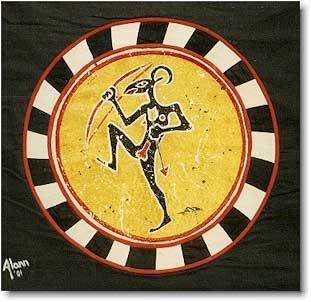 The hunter (embroidered on cotton in Pokhara, Nepal 2001)
The hunter (embroidered on cotton in Pokhara, Nepal 2001)
 Maha Kali (1994 Puri / India)
Maha Kali (1994 Puri / India)
My way of representing gods in India has often stirred emotions or raised eyebrows. Like my painting of Maha Kali's mouth, encircled by Shiva lingams.
Mr. Siddiqui, a Bengali Muslim art critic asked me: “Aren't you a bit too bold in that? Don't you think it's bold to depict Gods in that way?” I answered that I wasn't any bolder than the Hindu art heritage. That there were enough myths and stories telling about the way Shiva made love to Parvati, his wife and she to him. So, what am I doing bolder than what has been done already? Only that I make it a bit more modern in approach.
DH- Well, let's put it this way. This comes down to another question, which is? Should, at the end of the day, should people be protected from certain images and thoughts and ideas, surely people have a freedom not to see certain things. And the same for us, surely we have a freedom not to be confronted with certain ideas by big individuals, they repressed for my benefit, say. They might not like the way I dress or look or represent something to them and rather they come and slug me in the street they keep it within themselves. We're talking about a type of freedom here. Whereas a Tshirt is kind of a... A- Call it mobile art.
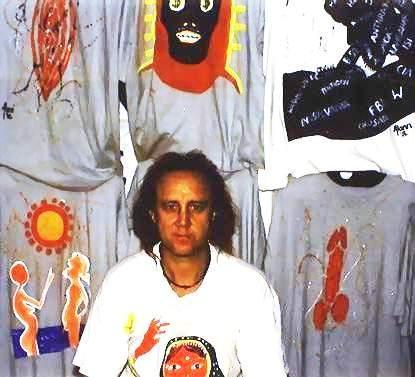 Hand painted T-shirt (Goa India 2002)
Hand painted T-shirt (Goa India 2002)
DH- Obtuse isn't it? It becomes kind of obtuse, yeah, I've seen this down the road where I saw a T-shirt and I said: "Wow, I've enjoyed, other people might not..."
And some now: “I do not”, which I do find offensive. Actually, this is straight American slang. It affects me and I say to myself: “I would rather not be faced with that; that's come close.”
A- A T-shirt could also be what we say “the clothes make the man”. I think that really comes very close to a T-shirt nowadays. A T-shirt is very much says what the person wants to say if he chooses a slogan, an image or a drawing, it tells who the man is.
DH- Yes, it does say a lot But on the other hand it becomes so fashionable...Recently in Bangkok I ran into a girl on the street and look what she was wearing. She was wearing a T-shirt saying: “Gas the Jews, gas the Gypsies, gas the gays and long live Nazism.” And she was wearing that probably not knowing what it meant because it is very fashionable in Thailand to wear English spoken T-shirts. I told her- of course it was kind of delicate to tell her, Thailand being a non-confrontational culture- that it was very bad what it said. I asked if she knew what she was wearing? She must of thought: “what is this strange farang trying to tell me?"
She smiled sheepishly at me. I told her again and again in my broken Thai. This T-shirt shocked me. I am sure she had no clue, she didn't understand English. So, yeah some people should be protected from things or seeing things if they don't know what they are seeing.
DH- Yes, however, if you believe in freedom, it's her choice. A- But she probably did not know what it said. I mean Thai
teens love to wear a shirt with buzzing American or English sounding phrases. As long as it's Western, people buy it out of sheer snobbery...
DH- A gas does have actually different meanings too, doesn't it. You know, there's an expression: “It's a gas.”
A- “Bergen Belsen was a gas”, a line out of a Sex Pistols song sung by Ronnie Biggs (England‟s most wanted and notorious bank robber of the century).
DH- Yeah, there's something about that T-shirt that, which meant to say: It‟s OK. It‟s (the holocaust) passed you know.
A- This is obviously not the meaning.
DH- It could have been promoting, it could have been the meaning to promote these ideas.
A- You can say something is a gas but " Gas the Jews and gas the Gypsies, that's really...
DH- Yeah, right, right. (Conceded)
A- Coming back on the pictures. What were you saying before we started talking about the T-shirts?
DH- Yeah, we're looking at one of the problems with Tshirts. It's a medium whereby someone doesn't have the choice to go and view. They're confronted with it. And this maybe applies to pictures too...? Or, anything somebody says, yeah.
A- I think it's a mobile art form.
DH- if people have feelings, there's the feeling of the person who is producing the item and there's the feeling of the person who will be confronted with the item. It's a difficult issue. For instance, say like with the book, yup. The cover tells me within its bounds what the contents are,
however, if I was to come across the book that says one thing, yet, to and behold inside is saying another. There I felt cheated. The content of the book is basically cheating me. The cover has cheated me.
A-They also say: “Don't judge the book by its cover.”
DH-This is true isn't it?
A- The same goes for people. Now, this is contradictory. People say: “You can't tell who the man is by his clothes” and on the other hand they say: “Don't judge the book by its cover.” I mean we have prejudices when we meet people. Even- though I don't want to admit it, usually, when at first glance I meet somebody, I may think: I like this person or I don't like him.” I come to like or dislike a person, because we have of our prejudices, with which we have been brought up.
DH- I tell where I really disagree with what has happened...is whereby you have somebody produce a piece of art, it goes to a gallery. People are unaware of what it is and what it contains, get out on the street, go to the door, pay to go in knowing it's there, looking at it and then complaining as saying: “It has offended me."
That is wrong. They had a choice not to. If you don't like, if it's not something appropriate for you, then you should go areas that is. But to go in and to play judgemental that is where censorship is. Somewhere someone has broken the bounds of good censorship because by providing a door and money to go in, you provide a cover and a censorship, because by providing a cover and a censorship for everyone, for everyone's interest. And as soon as people do that then it is like, that they have no grounds for complaint, surely.
A- Yeah, we're coming close to a subject of censorship,
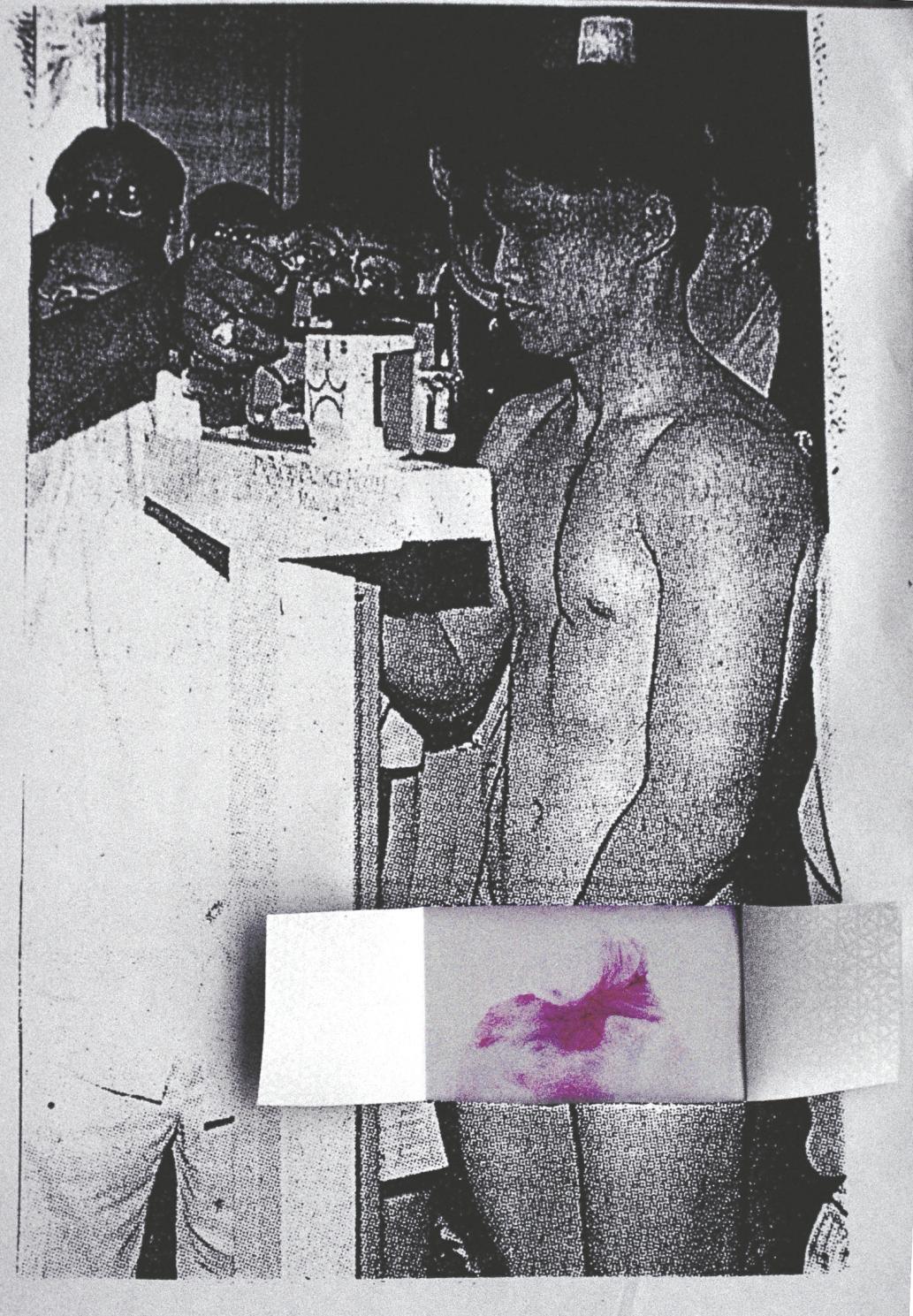 THAI HEROES I (Restauration of censored Champion Thai Boxers with Alann’s print of his own genitals /Bangkok 1997)
THAI HEROES I (Restauration of censored Champion Thai Boxers with Alann’s print of his own genitals /Bangkok 1997)
right? Now you find it everywhere. Hindu, Muslims, and Christians like are behaving like fundamentalists very much this last decade.
DH- There's also a lot of liberalism though, as we travel. Do you think everybody experiences censorship; it's a point isn't it? There are so many things as a child that I had something in my mouth to say like a big apple I couldn't even swallow it nor get it out. I was like these pigs on the table, you know, with their mouth over the apple. I've got the realization about someone in the family or a fact or something. They neither allowed me to say nor allowed me to...there's censorship. „Cause you can't criticise a teacher? Can you say as a pupil: “Look teacher, you are not doing too well, do you? I may not be an excellent pupil, but you're far from an expert teacher, yah?”
A-For that reason I have been many times in trouble. I was chucked out of school because I was the only one who really got tired of being told by our teacher, who was a catholic brother, what to believe. He taught us religion. This guy was so old and stuck in routine that he never saw the times changing. He thought: “Well, another class is another class.” We had to read this Catholic parochial weekly and study what he had read out to us and discuss in the classroom. That little newspaper was the material for our tests. There was one topic on the Pope, which he did not want to question. It said as much that The Pope was infallible. I didn't agree and openly went into debate with the teacher, but it was impossible. His opinion was the truth.
I told him if there wasn't any openness in debating this I didn't see any further interests to just study this matter like a parrot. He actually prohibited me from speaking in
the class for the rest of the term. When I had a test I refused to fill in anything. That's how I got flunked and expelled from school.
People told me I should have compromised and think about my future career, etc. But I didn't. This rebellion goes on even here in India. As soon as somebody tries to swindle me or starts to show off a sort of authority I will not take it, whether it's at the bank, the post office or at my teaching job. My hair stands on end, and I won't budge, on the contrary. I cannot accept authority and that's probably why I still rebel against censorship, against people, who say what I may paint and may not paint. About people who are saying that since I am born in this society, I should behave according to the laws that the authorities made.
So I am an anarchist. I believe I was born a free person and they should allow me to be free within that context.
If I want to run naked, let me run naked. Now if I would go...I'm going to run around in a loincloth here in India. I wonder what would happen. Would they arrest me? Would they think I am a crazy guy like you find some of those crazy people running half naked through the streets or sleeping naked? You can see they have a disturbed mind. They are psychotic.
But if a tourist or a Westerner were to do it, just like a sadhu (a Holy man in India and Nepal), I wonder what would happen, would they arrest me?
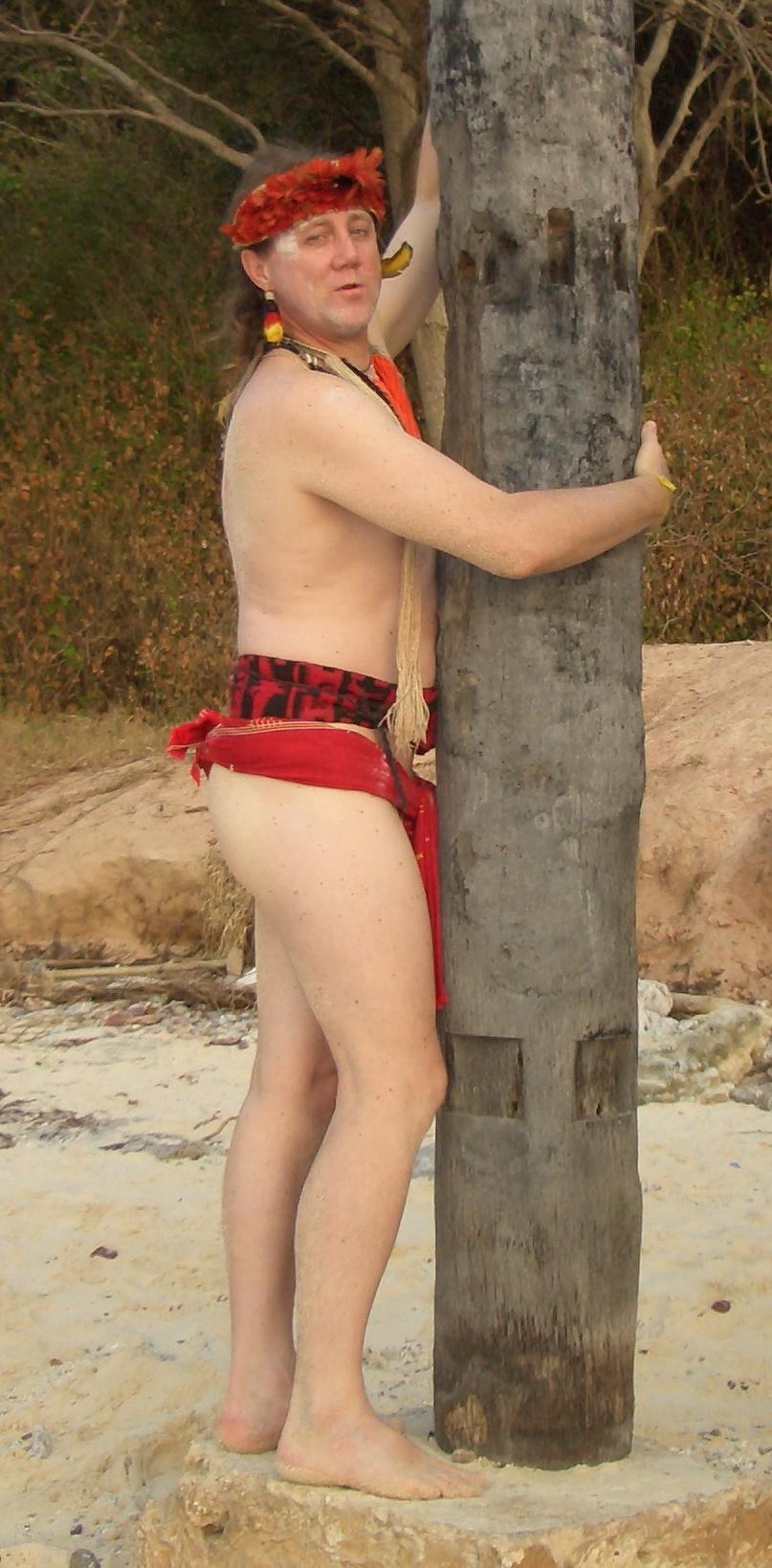 Alann in trance during a shamanic ritual on the beach in Rayong, Thailand 2007
Alann in trance during a shamanic ritual on the beach in Rayong, Thailand 2007
Our lord 1997
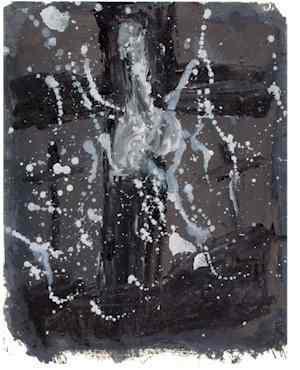
DH- Yes, one of the things you said, was that you were accused of being a sorcerer and then possibly you are a sorcerer of a type, you said yesterday.
A- As a painter...
DH- yah A- ...a sorcerer creating magic, and I was thinking about the fact that I was painting. It dawned on me only now, that I painted some villagers in 1989 and again in 1991 I did faces, of everyone, which they had probably never seen in their life. They never had a painter staying in their village before. Contact with our world they only had through the missionaries and the Brazilians...I had never thought of that. It' only now because you think of a sorcerer that I thought: wow, maybe they have seen me as a sorcerer, because I was able to put their picture on a piece of paper, which had never been done before, except maybe through photography.
They only used to describe geometrics on pottery or on rugs. I was accused of practicing sorcery, surely with the help of the evangelist in the neighbouring village, who saw me as a threat to their christening them. You see, I tried to revive the indigenous beliefs, which the missionary have tried to destroy for as long as they stayed with the Shavante – I think for them the idea that there were white men who didn‟t believe was a perceived as a threat to what they had accomplished with the Shavante.
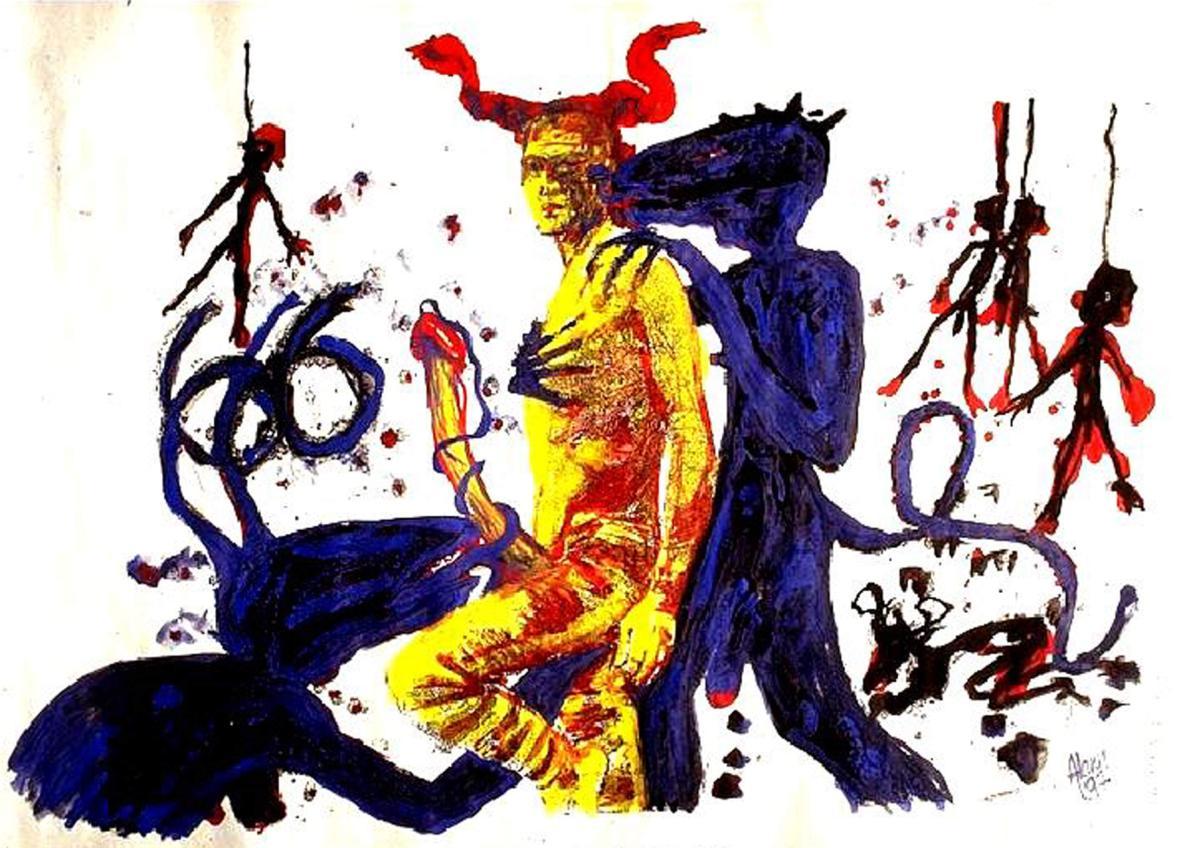 The Dark Side In Us (1997 Kolkatta/ India)
The Dark Side In Us (1997 Kolkatta/ India)
DH- Yes...
Alann, I'm looking at a picture with a marvellous imagery here. It appears to have a lot of demons here. One hand on the shoulder, one on the other, one roughly where the heart is and there seems to be an intoxicated feel here.
DH- Can you tell us more about what the picture means, what is behind it?
A- It's basically about the darker forces that exist within people. A acquaintance of mine, when she saw the pictures in my catalogue, which was in black and white, said that she couldn't associate my face with that picture. I looked more like a psycho or something. So, I told her that everyone has these darker sides and that I have mine too. The Christian doctrine teaches us that we all have to glorify the good in us, which I don't believe...
It's said also that good does not exist without bad. Night does not exist without day. God does not exist without the devil. We're always told in Christianity to crush and oppress the bad and become the pure and innocent, which we are never. I never believe that we can only be good and I sometimes feel to flirt with the bad in me.
Going back to my childhood I remember that, like lots of boys did, I once to cut off a frog‟s legs for fun and used tear off the wings of a fly. I also put different species of ants together in a glass container to see them fight, or get them to eat a snail in there. All kids do that at one stage or another in their lives. So is bad bad? Or does it depend from which angle you are looking at it? It's the same with the notion of freedom fighters. On the one hand they can be labeled terrorists and on the other hand we may think of them as freedom fighters.
DH- And then we have in the background there appears to be almost a tremendous amount of light coming down and
also it seems to be piercing darkness.
(Alann handing over a slide of a detail of that picture) We have another one (demon) who is either licking my penis or has it in his mouth or it is his tongue sticking out. It's up to you what you want to see in it. Another person, a friend of mine, saw in the horns of the beast the numbers 666. And this was a coincidence, I mean, I had drawn the horns like that and it came out to be that he saw the number of the beast in it and it's about badness and about Satanism. So, yes, you have the light in the back, which is the light that I can't grasp. The light we need in times of despair and have difficulties in seeing, the light of divinity. God, goodness, but I‟m turned with my back towards the light so I don't see the light. But, I feel the badness physically. I even hold it. In the light you also see dangling bodies, people who were hanged in the foliage of the jungle.
It's a jungle, life is a jungle. Everything is a jungle. The life we lead, where (place) we lead it. I am also wearing horns, I am partly beast and partly human, because we try to crush everything which is 'animal' in us. We have a need for war but also for domesticating wild things.
Check out Alann‟s website at: www.alann.exto.org Copyright 2010, all rights reserved.
